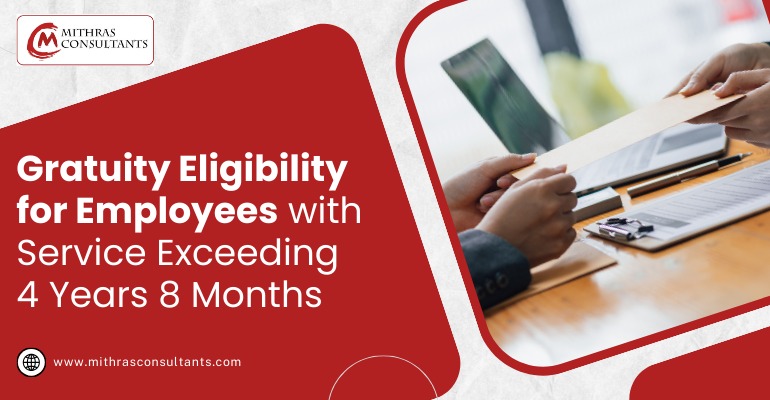Gratuity Eligibility for Employees with Service Exceeding 4 Years 8 Months

The Payment of Gratuity Act, 1972 (the Act) serves as a foundation for employee gratuity in India. However, determining eligibility for employees with service exceeding four years but falling short of the five-year threshold can be complex. The landmark case of Mettur Beardsell Ltd. (represented by Its Personnel Manager), Madras vs. Regional Labour Commissioner (Central) (Madras & Others) (1998 LLR 1072) offers valuable insights into interpreting the Act and resolving such situations.
The Power of 240 Days: What Is “Continuous Service”
At the core of the Madras High Court case lies the interpretation of “continuous service” as defined by the Act. Section 2A plays a pivotal role, clarifying that an employee rendering service for a period of 240 days in a year is deemed to have completed one year of continuous service.
In the specific case, the employee had served for 4 years, 10 months, and 18 days. While this period falls short of five calendar years, the critical point is that 10 months and 18 days exceed 240 days. By applying Section 2A, the court effectively added weight to the service duration. It deems the employee to have completed five years of continuous service, thereby making them eligible for gratuity.
Beyond Calendar Years: Dispelling a Common Misconception
The employer in the case argued that a completed year necessitates 12 calendar months of service. However, the court rejected this interpretation. Sections 2(a), 2(b), and 2(c) of the Act define “one year,” “completed year,” and “continuous year” based on service exceeding 240 days, not strictly adhering to a fixed calendar year concept. This clarification is significant for employees who might fall short of five calendar years but have demonstrably served for periods exceeding 240 days in each year.
Continuity of Service Across Entities: Preserving Employee Benefits
The case also sheds light on situations where an employee transitions from an old firm to a new partnership firm. The court’s verdict emphasizes that if the new firm doesn’t obtain a written undertaking from the employee stating they will become their employee, the service rendered with the previous firm counts towards gratuity eligibility. This protects the employee’s accrued benefits and ensures continuity in service calculations even during firm transitions.
A Broader Look at Gratuity in India
Understanding the implications of the Madras High Court case empowers both employers and employees. Here’s a breakdown of key takeaways:
- Gratuity Eligibility for Service Exceeding 4 Years and 8 Months: An employee with service exceeding 4 years and 8 months (or more, exceeding 240 days in the fifth year) can qualify for gratuity under the Act. The 240-day threshold in a year plays a crucial role in determining continuous service.
- Importance of Section 2A: Section 2A plays a crucial role in interpreting continuous service, considering days served over a fixed calendar year. This ensures a more nuanced approach to calculating service duration for gratuity purposes.
- “One Year” Defined by Service, Not Calendars: The definition of “one year” and “completed year” is based on service exceeding 240 days, not strictly 12 calendar months. This broader definition prevents employees from being penalized due to arbitrary calendar year limitations.
- Continuity of Service Across Entities: When transitioning from an old firm to a new one, service with the previous firm can be considered for gratuity if there’s no undertaking to become an employee of the new firm. This protects employee benefits during firm transitions.
Essential Considerations for Employers and Employees
The legal space surrounding gratuity can be multifaceted. Here are some additional points for employers and employees to consider:
- Calculating Gratuity Amounts: The actual gratuity amount involves factors like the last drawn salary, the number of years of service (including fractions of a year exceeding six months), and a specific formula mandated by the Act. Consulting a financial professional or HR specialist can ensure accurate calculations.
- Variations and Amendments: There might be variations based on specific company policies or state amendments to the Act. Consulting the latest version of the Act and any relevant state-specific regulations is advisable for both employers and employees to ensure compliance and avoid potential disputes.
- Employee Category Matters: The Act excludes certain categories of employees, such as apprentices or those in managerial positions, from gratuity benefits. Determining the employee’s category is crucial for accurate gratuity calculations and to avoid misunderstandings.
Hope this article makes it easy to understand these aspects. Employers can ensure fair and compliant gratuity practices, while employees can be well-informed about their rights and entitlements under the Act. If you have any specific questions or require further guidance on a particular situation, discussing with a professional like Mithras Consultants is highly recommended.

 Call Us
Call Us Whatsapp Us
Whatsapp Us